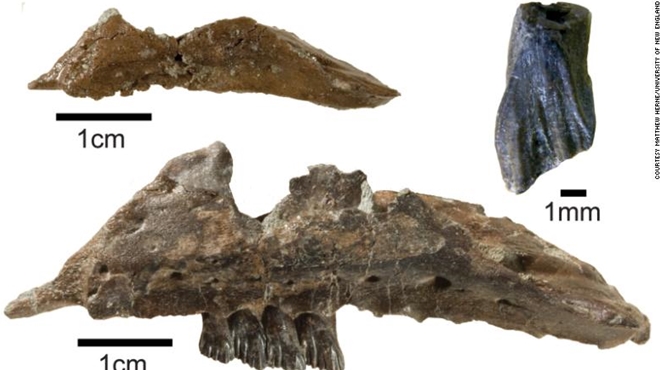Dinosaur fossil found in Australia was about the size of a wallaby
Wallabies are diminutive members of the taxonomy that also includes kangaroos, and they can be anywhere from just under a foot to 3.2 feet tall.
Galleonosaurus dorisae is named both for the shape of its jaw, which resembles the hull of a galleon ship, and for paleontologist Doris Seegets-Villiers, who has studied fossils in the area.
The findings were published Monday in the Journal of Paleontology.
 |
| Fossils and a 3D CT model of the newly named dinosaur Galleonosaurus dorisae. |
The dinosaur would have been a small yet quick member of the large family called ornithopods, which also included iguanodons.
"These small dinosaurs would have been agile runners on their powerful hind legs," said Matthew Herne, lead author of the study and a postdoctoral fellow at the University of New England in New South Wales, in a statement.
The researchers found the five jaws, ranging from young to mature, in the same area as other small ornithopods. This indicates that they liked the forest-covered floodplain of the ancient Australian-Antarctic rift valley millions of years ago.
The finding "confirms that on a global scale, the diversity of these small-bodied dinosaurs had been unusually high in the ancient rift valley that once extended between the spreading continents of Australia and Antarctica," Herne said.
Gallenosaurus was buried in volcanic sediments carried by what was once a network of deep, swift rivers. Herne and his team also found Diluvicursor pickeringi, another small ornithopod, in the area in 2018, but Gallenosaurus is 12 million years older. The researchers believe this shows that dinosaurs were living and evolving in the rift valley for a long time.
The rivers carried the volcanic sediments into the valley to form deep sedimentary basins. Over time, they mixed with dinosaur bones and fallen trees.
"This land has now vanished, but as 'time-travellers' we get snapshots of this remarkable world via the rocks and fossils exposed along the coast of Victoria," Herne said.

